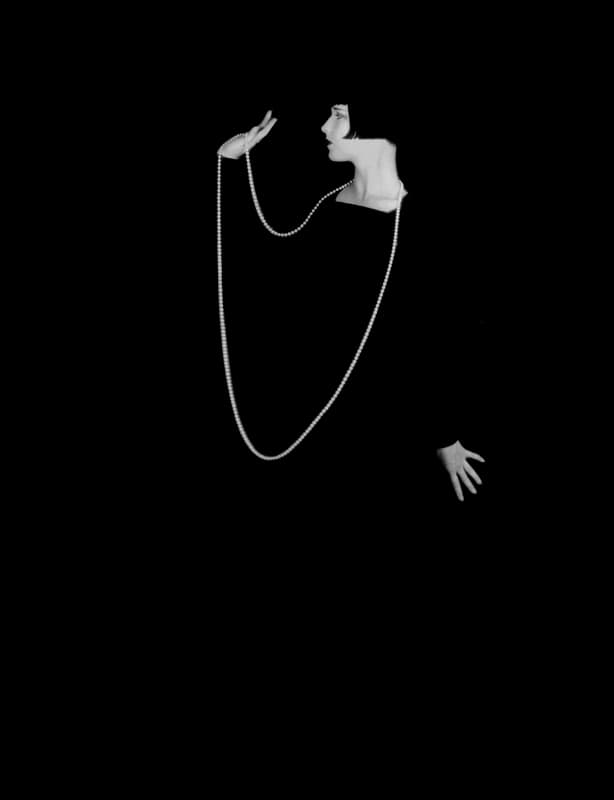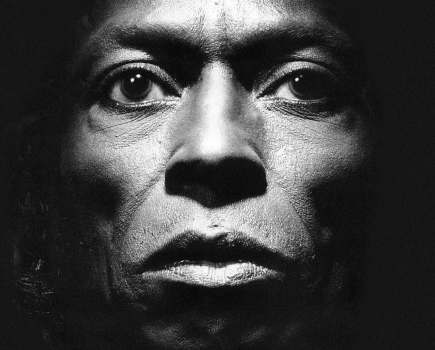Image: American actress Louise Brooks wearing a long necklace that stands out against a black background, 1928 © Eugene Robert Richee/John Kobal Foundation/Getty Images
During the film industry’s rapid development in the early part of the 20th century, the demand for publicity photos increased. Audiences were hungry for images of screen idols such as Greta Garbo, Charlie Chaplin, Buster Keaton, Rudolph Valentino and Lillian Gish. Studios wanted to retain control over the public image of their stars, so they set up their own specialised and well-equipped photography departments.
Many photographers made their name shooting promotional portraits for fan magazines and posters. Their job was to create idealised images of leading actors and make them appear glamorous and physically flawless. These photographers included George Hurrell and Ruth Harriet Louise at MGM, Jack Freulich at Universal Studios and Eugene Robert Richee at Paramount Pictures.
In 1928, the Colorado-born Richee was a 32-year-old photographer who had worked for Paramount for seven years. During his career he had shot portraits of all the studio’s major stars, including Clara Bow, known as ‘The It Girl’, and Fay Wray, who later starred in the original King Kong.
Richee was known for being both painstaking and technically inventive in his work, and he became one of the most accomplished movie-studio photographers working at that time. He skilfully used the cumbersome, large-format 10x8in studio cameras of the period and was meticulous in his placement of lights. He was also known to sometimes include light-reflecting props made of plastic or glass to give additional radiance to his subjects. One of the stars he photographed most frequently was Louise Brooks.
Brooks, born in 1906, became an icon of the silent film era and was later described by the critic Kenneth Tynan as ‘the most seductive, sexual image of woman ever committed to celluloid’. She had begun her career as a dancer and was signed by Paramount in 1925. She was particularly known for her distinctive and stylish ‘bob’ hairstyle, pale skin and smouldering brown eyes.
By 1928 she had appeared in 12 films and had achieved celebrity status, with numerous famous friends including the millionaire newspaper publisher William Randolph Hearst. Her appearance inspired many other women to adopt the bob haircut, which became a popular style in the late 1920s and early ’30s.

Image: An alternative perspective on Brooks, taken by Richee
during the ‘pearls’ photo shoot © Eugene Robert Richee/John Kobal
Foundation/Getty Images
Richee photographed her in a number of shoots using a variety of costumes and styles. Undoubtedly, the most striking and inventive of these portraits were those shot in the 1928 photo session in which she is shown in a black dress against a black background, holding a long string of pearls.
The most famous of these images is a masterpiece of minimalism, which gains strength from its simplicity. Brooks is shown full-length and in profile, with the short bob curling across her cheek towards her mouth. The angular shapes in her profile and hands contrast with the flowing shape of the pearls.
The black, long-sleeved dress and background merge together so that the only visible elements are her head and neck, her hands and the string of pearls. The seamless black surrounding those elements was enhanced after the 10×8 negative was developed; retouching negatives was standard practice and Richee (or his assistant) would simply have scratched any remaining details from the surface. The resulting photograph’s high-contrast, graphic quality captures the ground-breaking spirit of ‘Roaring Twenties’ fashion.
The other photograph to survive from that session is another elegant profile shot, but this time only shows Brooks’ head and shoulders.
These pictures record Brooks on the cusp of the most successful and notorious phase of her brief career. The following year she suddenly quit Paramount and went to Europe to star in two controversial films by the Austrian director GW Pabst, called Pandora’s Box and Diary of a Lost Girl.
These two classic films, both considered shocking at the time for their sexual themes, signalled her arrival as a major film star. However, Brooks’ rebellious, headstrong personality led to her refusing to complete work on her last film for Paramount and being informally blacklisted in Hollywood. By her late 20s, her career was effectively over.
She struggled to find further roles and only worked in films sporadically before officially retiring in 1938. Later occupations included working as a sales assistant in a department store and a period working (by her own admission) as a ‘call girl’ for wealthy clients. Intelligent and articulate, she later wrote an entertaining memoir, Lulu in Hollywood (1982). She died in 1985.
Richee, meanwhile, worked for Paramount for 20 years and later on a freelance basis for MGM and Warner Brothers. He photographed a range of popular stars, including Marlene Dietrich, Dorothy Lamour, Mae West, Gary Cooper and Gloria Swanson, and was well known and respected in the industry. He retired in the early 1960s. It’s known that he died in Orange County, California, USA, in 1972, but relatively little else is recorded about his life. Today, his reputation remains sadly neglected.
 Image: Eugene Robert Richee with his assistants photographing Marlene Dietrich at home, 1935 © Eugene Robert Richee/John Kobal Foundation/Getty Images
Image: Eugene Robert Richee with his assistants photographing Marlene Dietrich at home, 1935 © Eugene Robert Richee/John Kobal Foundation/Getty Images
The enigmatic Brooks made little comment about her experiences of being photographed by Richee, apart from one characteristically succinct remark. ‘Eugene Richee used to take 60 shots in two hours,’ she said. ‘We never said a word to each other. Perfect relationship.’
Books and Websites
Books: Richee’s work is included in John Kobal’s 1988 book, The Art of the Great Hollywood Portrait Photographers (used copies are available on www.amazon.co.uk). For more information on Louise Brooks, see Louise Brooks: A Biography by Barry Paris (1989).
Websites: For more information on Louise Brooks, see www.pandorasbox.com. A selection of Richee’s portraits of Brooks can be seen on this website’s portraits pages. Lulu in Berlin, a rare 1973 interview with Louise Brooks by Richard Leacock, is available on www.youtube.com.
Events of 1928
- 19 April: Final volume of the first edition of The Oxford English Dictionary is published
- 1 May: The Flying Scotsman locomotive pulls the first steam-hauled express train from London to Edinburgh. It runs the 392-mile journey without stopping, breaking the previous record for a scheduled service
- 17-18 June: Aviator Amelia Earhart travels from Newfoundland to Britain in an aircraft piloted by Wilmer Stultz and becomes the first woman to successfully cross the Atlantic Ocean
- 3 July: Scottish inventor John Logie Baird demonstrates the world’s first colour television transmission
- 28 July: Official opening of the 1928 Summer Olympics in Amsterdam, Netherlands
- 28 September: Biologist Alexander Fleming discovers penicillin, an event which marks the beginning of modern antibiotics
- 10 October: The Tyne Bridge, which connects Newcastle upon Tyne with Gateshead, is officially opened by King George V
- 6 November: Republican Herbert Hoover defeats Democrat candidate Alfred E Smith to win the US presidential election
- 18 November: The first sound film, a Mickey Mouse cartoon titled Steamboat Willie, is released
- 22 November: Premiere of composer Maurice Ravel’s most famous work, Boléro, at the Paris Opera in France








